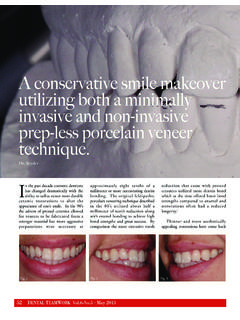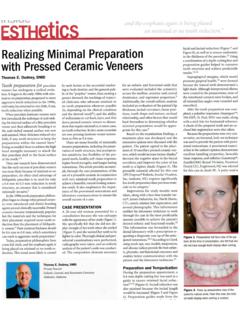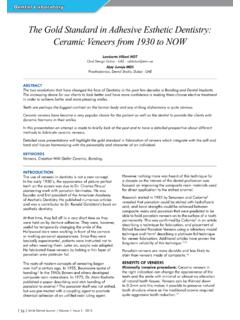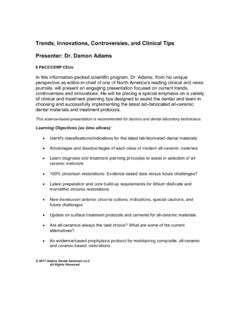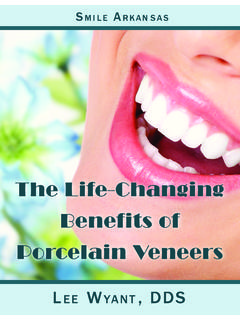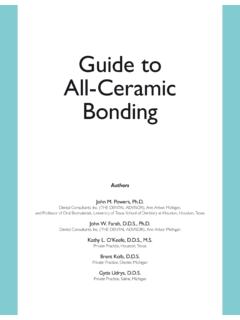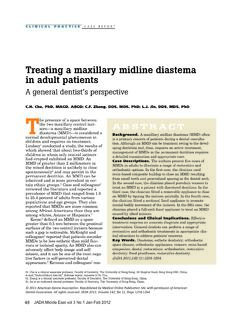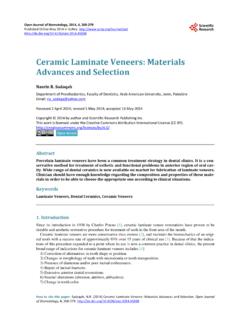Transcription of A conservative smile makeover utilizing both a minimally ...
1 CJRDP_V6N2_Summer13_Layout 1 13-07-05 10:59 AM Page 62. Esthetic Dentistry/Dentisterie esth tique A conservative smile makeover utilizing both a minimally invasive Todd C. Snyder, and non- invasive prep-less porcelain DDS, AAACD. veneer technique. R fection conservatrice d'un sourire, utilisant la fois des tailles minimales et la technique non- invasive de facettes en procelaine. Par Todd C. Snyder, DDS, AAACD. Abstract Creating a beautiful smile for our patients is very rewarding but it can also be very challenging. Ceramic veneers have changed the way we approach treating patients in the past twenty five years. Whether it is restoring one tooth or a whole smile with ceramic veneers it is nothing short of amazing in the difference we can make to someone's appearance and life.
2 When veneers were first introduced, they were a minimally invasive procedure to alter the appearance of the teeth and the smile . For many the veneering process changed with time and the advent of newer materials into a more invasive means to alter a smile with the cost often being significant tooth reduction of the teeth and the exposure of dentin. In more recent years, modern lithium disilicate ceramics with their higher strength properties have allowed for less invasive tooth reduction or no reduction just like traditional preparation designs done with feldspathic ceramics. Furthermore due to enhanced material strength and improved optical properties the ability to create true to life aesthetics with modern materials can again be achieved in extremely thin restorations.
3 N the past decade cosmetic dentistry has changed with the introduction of lithium disilicate restorations. I dramatically with the ability to utilize newer more durable ceramic restorations to alter the appearance of one's smile . In the 90's the advent of pressed These modern high strength ceramics can be utilized to fabricate conservative veneers that are approximately three tenths of a millimeter in thickness just like ceramics allowed for veneers to be fabricated from a feldspathic porcelains. Further advances in the lithium stronger material but more aggressive preparations were disilicate chemistry have also created improvements in necessary at approximately eight tenths of a millimeter both translucency and aesthetics.
4 The material can be or more necessitating dentin bonding. The original utilized for very thin restorations with life like feldspathic porcelain veneering technique described in characteristics very much like traditional the 80's utilized about half a millimeter of tooth reduction stacked/feldspathic porcelain veneers yet having along with enamel bonding to achieve high bond substantially higher material strength properties. The strengths and great success. By comparison the more current ability to alter the appearance of teeth while extensive tooth reduction that came with pressed maintaining enamel to adhere to and utilizing strong ceramics utilized more dentin bonding which at the time pressed ceramics or traditional feldspathic porcelain is offered lower bond strengths compared to enamel and as good as or better than ever before.
5 The continued restorations often had a reduced growth in smile makeovers and porcelain veneers Thinner and more aesthetically appealing restorations continues to be an area of interest as public awareness have come back into popularity in more recent years grows from more visibility in movies, television and other 62 Canadian Journal of Restorative Dentistry & Prosthodontics/Journal canadien de dentisterie restauratrice et de prosthodontie Vol. 6, No. 2 Summer/ t 2013. CJRDP_V6N2_Summer13_Layout 1 13-07-05 10:59 AM Page 63. Esthetic Dentistry/Dentisterie esth tique Cr er un joli sourire pour nos patients est tr s satisfaisant, mais peut tre aussi tr s difficile.
6 Les facettes de R sum . c ramique ont modifi s la fa on dont nous approchons tout traitement pour les patients, durant ces derni res vingt ann es. Que ce soit la restauration d'une dent ou tout un sourire, avec des facettes de c ramique, il n'y a rien de plus extraordinaire, de par la diff rence, que nous ne puissions faire pour l'apparence, et pour la vie de quelqu'un. Lorsque les facettes apparurent pour la premi re fois, c' tait un proc d moyennement invasif pour changer l'apparence des dents et du sourire. Pour plusieurs, le processus de recouvrement a volu , avec le temps et la venue de nouveaux mat riaux, pour des moyens plus invasifs afin de modifier le sourire, au prix, souvent significatif, de r duction des dents et d'exposition de la dentine.
7 Au cours des derni res ann es, des c ramiques modernes de lithium disilicate avec des propri t s de haute r sistance, ont permis de moins invasives r duction des dents ou pas de r duction ; tout juste comme dans les traditionnelles conceptions de pr parations faites pour les c ramiques feldspathiques. De plus, d des mat riaux de grande r sistance et aux propri t s optiques am lior es, l'habilit de cr er une esth tique plus fid le que vraie avec des mat riaux modernes, peut nouveau tre obtenu par des restaurations extr mement minces. media. Based on aesthetics, strength and technique restorations. Additionally digital photographs can be there are many options available to alter our patients measured and evaluated for symmetry and proportion appearance, but more importantly that anyone can offer where modifications, possible treatment procedures and the procedure where applicable with minimal to no outcomes can be hypothesized and created.
8 Outlines of damage of the tooth structure. Through proper training various teeth shapes can be overlaid onto the existing and the use of talented technicians we can make dentition digitally whereby the aesthetics and positions incredible changes in a patient's appearance and recreate of teeth and gums can be evaluated more thoroughly by beautiful, natural smiles to enhance their lives far better the dentist, specialists, technicians and the patient. than they could ever imagine while being minimally Ultimately a diagnostic wax-up needs to be created by invasive . using the various forms of input on shape, texture, color, In this case a patient presents post orthodontic translucency and The diagnostic wax-up, upon therapy with the desire to close spaces, change the approval from the patient, is considered the final shape and remove unsightly decalcifications on the treatment plan and can then be used to fabricate a anterior teeth.
9 The patient presented with no periodontal template to create an actual mockup on the patient of disease and a stable posterior occlusion, but has minimal the final shape/appearance for further evaluation and canine guidance. The treatment plan would be to have verification. In this case the maxillary incisors were in a the patient's teeth cleaned followed by impressions to favorable position facially and adding an additional layer create four sets of diagnostic models. The first set would of porcelain was determined to position the facial remain untouched documenting how the case originally surfaces out further than what would be aesthetically presented. The second set would be used to fabricate pleasing.
10 These teeth would need minimum reduction custom whitening trays for the patient to use at home to resurface the facial aesthetics and add to the incisal prior to starting the case while the diagnostic waxup edges. The canines were determined to be deficient was being fabricated. The third set of models would be bilaterally from the center line of the tooth to the mesial to use as a practice preparation model where testing of contact along with the incisal edge needing to be the hypothetical veneer design takes place. The fourth lengthened. set of models would be sent to the laboratory for a Based on the diagnostic wax-up and the preparation diagnostic waxup where the models would be waxed to designs attempted on the diagnostic models the dentist ideal contours (while taking into account the patient's and ceramist can determine the type of material to be desired appearance) so that jigs and reduction guides utilized and any unforeseen problems or hypothetical could be fabricated.
